Stuffed peppers
Stuffed peppers are a traditional dish in many countries and are prepared using pitted peppers . Rice or minced meat is usually used as a filling. Typical preparation is braising in the oven or in a closed pot, usually in a tomato sauce .
The filled peppers came to Hungary through the Turks, from where they became known in Europe during the Habsburg period. At that time the Hungarians only knew stuffed cabbage .
history
After the paprika fruits emerged throughout Eastern Europe and the Middle East, their box-like shape was found to be ideal for filling. The cooks filled them with minced meat, cereals and other mixes, boiled or braised them. The Hungarians had previously prepared peppers stuffed with sauerkraut. Paprika fruits filled with cheese are particularly popular in Italy, Hungary and the Balkans. In Romania and the Balkans, so-called Italian peppers ( Cubanelle ) are used for this dish . Stuffed peppers became one of the few red pepper dishes adopted by much of the Ashkenazi community. Apparently the stuffed peppers came to the United States in the late 19th century .
variants
- Ardei umpluți - For the Romanian variant, you prepare the minced meat from beef and pork and mix in some rice . Parsley , dill and celery leaves are used as herbs . It is served in a tomato sauce with sour cream or yogurt. Side dish is often Mămăligă .
- Boston style - small fruits are filled with crab meat , then breaded and deep-fried.
- à la menagere (housewife style) - For this, you create a mass of sausage meat and rice and fill the fruit with it.
- Piperies Gemistes ( Greek πιπεριές γεμιστές ) - The Greek variant is filled with rice, onions, parsley, dill and mint. Minced meat ( kimas κιμάς) can be added.
- á la turque : paprika fruits filled with coarsely chopped cooked mutton and rice pilaf , optionally with raisins.
See also
literature
- Herring Lexicon of the Kitchen . Fachbuchverlag Pfannenberg, Haan-Gruiten, 23rd edition 2001, ISBN 3-8057-0470-4 .
- Erhard Gorys : The new kitchen dictionary . dtv, Munich 1994-2002, ISBN 3-423-36245-6 .
Web links
Individual evidence
- ^ A b New Larousse Gastronomique . Octopus, 2018, ISBN 978-0-600-63587-1 ( google.de [accessed on July 22, 2020]).
- ^ Alan Davidson: The Oxford Companion to Food . Oxford University Press, 2014, ISBN 978-0-19-967733-7 , pp. 401 ( google.de [accessed on July 22, 2020]).
- ^ Gil Marks : Encyclopedia of Jewish Food . Houghton Mifflin Harcourt , 2010, ISBN 978-0-544-18631-6 ( google.de [accessed on August 9, 2020]).
- ↑ Silvia Jurcovan: "Carte de bucate", Editura Humanitas, București 2012, p. 147, 426 ISBN 978-973-50-3475-7
- ↑ Sanda Marin: "Carte de bucate", Editura Orizonturi, București 1995, p. 87
- ↑ Richard Hering: Herings Lexicon of the Kitchen. Internationally recognized reference work for modern and classic cuisine. Ed .: F. Jürgen Herrmann. 25th edition. Pfanneberg, Haan-Gruiten 2012, pp. 527/528, ISBN 978-3-8057-0663-6 (first edition: 1907)
- ↑ Marianthi Milona (author); Werner Stapelfeldt (Ed.): Greece. Greek specialties. Könemann Verlag, Cologne 2001, ISBN 3-8290-7422-0 , p. 327.

